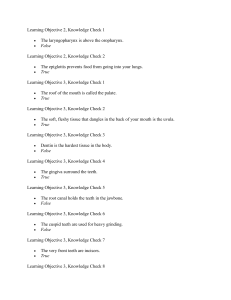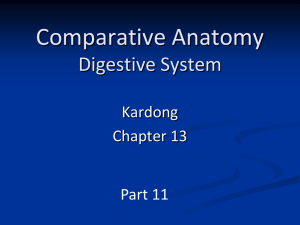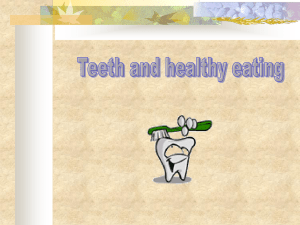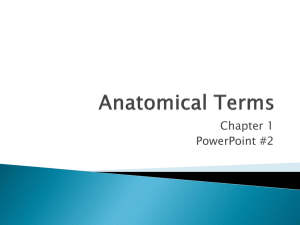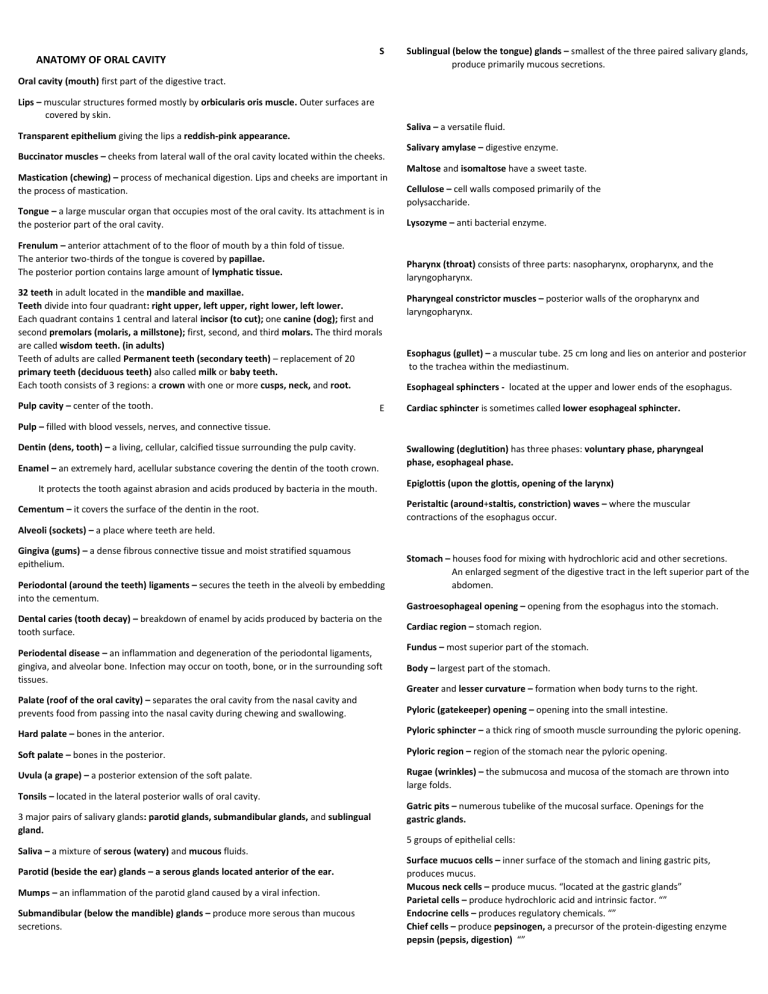
ANATOMY OF ORAL CAVITY S Sublingual (below the tongue) glands – smallest of the three paired salivary glands, produce primarily mucous secretions. Oral cavity (mouth) first part of the digestive tract. Lips – muscular structures formed mostly by orbicularis oris muscle. Outer surfaces are covered by skin. Saliva – a versatile fluid. Transparent epithelium giving the lips a reddish-pink appearance. Buccinator muscles – cheeks from lateral wall of the oral cavity located within the cheeks. Mastication (chewing) – process of mechanical digestion. Lips and cheeks are important in the process of mastication. Tongue – a large muscular organ that occupies most of the oral cavity. Its attachment is in the posterior part of the oral cavity. Frenulum – anterior attachment of to the floor of mouth by a thin fold of tissue. The anterior two-thirds of the tongue is covered by papillae. The posterior portion contains large amount of lymphatic tissue. Maltose and isomaltose have a sweet taste. Cellulose – cell walls composed primarily of the polysaccharide. Lysozyme – anti bacterial enzyme. Pharynx (throat) consists of three parts: nasopharynx, oropharynx, and the laryngopharynx. 32 teeth in adult located in the mandible and maxillae. Teeth divide into four quadrant: right upper, left upper, right lower, left lower. Each quadrant contains 1 central and lateral incisor (to cut); one canine (dog); first and second premolars (molaris, a millstone); first, second, and third molars. The third morals are called wisdom teeth. (in adults) Teeth of adults are called Permanent teeth (secondary teeth) – replacement of 20 primary teeth (deciduous teeth) also called milk or baby teeth. Each tooth consists of 3 regions: a crown with one or more cusps, neck, and root. Pulp cavity – center of the tooth. Salivary amylase – digestive enzyme. E Pharyngeal constrictor muscles – posterior walls of the oropharynx and laryngopharynx. Esophagus (gullet) – a muscular tube. 25 cm long and lies on anterior and posterior to the trachea within the mediastinum. Esophageal sphincters - located at the upper and lower ends of the esophagus. Cardiac sphincter is sometimes called lower esophageal sphincter. Pulp – filled with blood vessels, nerves, and connective tissue. Dentin (dens, tooth) – a living, cellular, calcified tissue surrounding the pulp cavity. Enamel – an extremely hard, acellular substance covering the dentin of the tooth crown. It protects the tooth against abrasion and acids produced by bacteria in the mouth. Cementum – it covers the surface of the dentin in the root. Swallowing (deglutition) has three phases: voluntary phase, pharyngeal phase, esophageal phase. Epiglottis (upon the glottis, opening of the larynx) Peristaltic (around+staltis, constriction) waves – where the muscular contractions of the esophagus occur. Alveoli (sockets) – a place where teeth are held. Gingiva (gums) – a dense fibrous connective tissue and moist stratified squamous epithelium. Periodontal (around the teeth) ligaments – secures the teeth in the alveoli by embedding into the cementum. Dental caries (tooth decay) – breakdown of enamel by acids produced by bacteria on the tooth surface. Periodental disease – an inflammation and degeneration of the periodontal ligaments, gingiva, and alveolar bone. Infection may occur on tooth, bone, or in the surrounding soft tissues. Stomach – houses food for mixing with hydrochloric acid and other secretions. An enlarged segment of the digestive tract in the left superior part of the abdomen. Gastroesophageal opening – opening from the esophagus into the stomach. Cardiac region – stomach region. Fundus – most superior part of the stomach. Body – largest part of the stomach. Greater and lesser curvature – formation when body turns to the right. Palate (roof of the oral cavity) – separates the oral cavity from the nasal cavity and prevents food from passing into the nasal cavity during chewing and swallowing. Pyloric (gatekeeper) opening – opening into the small intestine. Hard palate – bones in the anterior. Pyloric sphincter – a thick ring of smooth muscle surrounding the pyloric opening. Soft palate – bones in the posterior. Pyloric region – region of the stomach near the pyloric opening. Uvula (a grape) – a posterior extension of the soft palate. Rugae (wrinkles) – the submucosa and mucosa of the stomach are thrown into large folds. Tonsils – located in the lateral posterior walls of oral cavity. 3 major pairs of salivary glands: parotid glands, submandibular glands, and sublingual gland. Saliva – a mixture of serous (watery) and mucous fluids. Parotid (beside the ear) glands – a serous glands located anterior of the ear. Mumps – an inflammation of the parotid gland caused by a viral infection. Submandibular (below the mandible) glands – produce more serous than mucous secretions. Gatric pits – numerous tubelike of the mucosal surface. Openings for the gastric glands. 5 groups of epithelial cells: Surface mucuos cells – inner surface of the stomach and lining gastric pits, produces mucus. Mucous neck cells – produce mucus. “located at the gastric glands” Parietal cells – produce hydrochloric acid and intrinsic factor. “” Endocrine cells – produces regulatory chemicals. “” Chief cells – produce pepsinogen, a precursor of the protein-digesting enzyme pepsin (pepsis, digestion) “”


